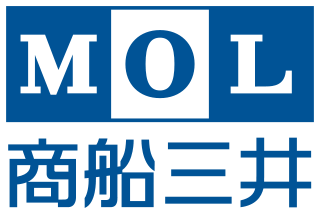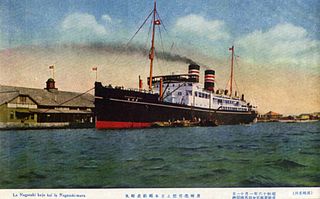Related Research Articles

Maritime transport or more generally waterborne transport, is the transport of people (passengers) or goods (cargo) via waterways. Freight transport by sea has been widely used throughout recorded history. The advent of aviation has diminished the importance of sea travel for passengers, though it is still popular for short trips and pleasure cruises. Transport by water is cheaper than transport by air or ground, but significantly slower for longer distances. Maritime transport accounts for roughly 80% of international trade, according to UNCTAD in 2020.

A steamship, often referred to as a steamer, is a type of steam-powered vessel, typically ocean-faring and seaworthy, that is propelled by one or more steam engines that typically move (turn) propellers or paddlewheels. The first steamships came into practical usage during the early 1800s; however, there were exceptions that came before. Steamships usually use the prefix designations of "PS" for paddle steamer or "SS" for screw steamer. As paddle steamers became less common, "SS" is assumed by many to stand for "steamship". Ships powered by internal combustion engines use a prefix such as "MV" for motor vessel, so it is not correct to use "SS" for most modern vessels.

A container ship is a cargo ship that carries all of its load in truck-size intermodal containers, in a technique called containerization. Container ships are a common means of commercial intermodal freight transport and now carry most seagoing non-bulk cargo.

Mitsui O.S.K. Lines is a Japanese transport company headquartered in Toranomon, Minato, Tokyo, Japan. It is one of the largest shipping companies in the world.

A cargo ship or freighter is a merchant ship that carries cargo, goods, and materials from one port to another. Thousands of cargo carriers ply the world's seas and oceans each year, handling the bulk of international trade. Cargo ships are usually specially designed for the task, often being equipped with cranes and other mechanisms to load and unload, and come in all sizes. Today, they are almost always built of welded steel, and with some exceptions generally have a life expectancy of 25 to 30 years before being scrapped.

A merchant ship, merchant vessel, trading vessel, or merchantman is a watercraft that transports cargo or carries passengers for hire. This is in contrast to pleasure craft, which are used for personal recreation, and naval ships, which are used for military purposes.

A boat or ship engaged in the tramp trade is one which does not have a fixed schedule, itinerary nor published ports of call, and trades on the spot market as opposed to freight liners. A steamship engaged in the tramp trade is sometimes called a tramp steamer; similar terms, such as tramp freighter and tramper, are also used. Chartering is done chiefly on London, New York, and Singapore shipbroking exchanges. The Baltic Exchange serves as a type of stock market index for the trade.

P&O was a British shipping and logistics company dating from the early 19th century. Formerly a public company, it was sold to DP World in March 2006 for £3.9 billion. DP World currently operate several P&O branded businesses, P&O Ferries, Istithmar P&O Estates, and P&O Maritime Logistics. It also operates P&O Heritage, which is the official historic archive and collection of P&O.

Safmarine, short for South African Marine Corporation, and latterly South African Marine Container Lines, was a South African shipping line, established in 1946, which offered freight transport services with cargo liners and container ships. It was bought by Maersk Line in 1999, and was fully integrated into that company in 2020. It also operated passenger vessels and specialised cargo ships.

Ellerman Lines was a UK cargo and passenger shipping company that operated from the late nineteenth century and into the twentieth century. It was founded in the late 19th century, and continued to expand by acquiring smaller shipping lines until it became one of the largest shipping firms in the World. Setbacks occurred through heavy losses to its merchant fleet in the First and Second World Wars but were overcome in each case.

American Export-Isbrandtsen Lines, New York, was the leading US-flag shipping company between the U.S. east coast and the Mediterranean from 1919 to 1977, offering both cargo ship and passenger ship services, until it declared bankruptcy and was acquired by Farrell Lines of New York.

Hamburg Südamerikanische Dampfschifffahrts-Gesellschaft A/S & Co KG, widely known as Hamburg Süd, was a German container shipping company. Founded in 1871, Hamburg Süd was among the market leaders in the North–South trade. It also served all significant East–West trade lanes.

A shipping line or shipping company is a company whose line of business is ownership and operation of ships.

Furness Withy was a major British transport business. It was listed on the London Stock Exchange.

A trunk deck ship is a type of merchant ship with a hull that was stepped inward in order to obtain more favourable treatment under canal toll rules then in effect. As those tolls were set by net tonnage, a measure of volume, and as the tonnage rules did not account for all of the cargo space of such vessels, trunk deck ships incurred lower tolls than more conventional ships of equivalent capacity. When the measurement rules were changed, the type was no longer built.

A cargo liner, also known as a passenger-cargo ship or passenger-cargoman, is a type of merchant ship which carries general cargo and often passengers. They became common just after the middle of the 19th century, and eventually gave way to container ships and other more specialized carriers in the latter half of the 20th century.

CSAV is a Chilean shipping company that is currently the largest company of its type in Latin America and also one of the oldest ones, having been founded in 1872.

The Ben Line or Ben Line Steamers, Limited was a Scottish shipping company based in Leith, Scotland founded in 1825 which was primarily involved in the Far East to Europe trade. A private company, it was largely owned by members of the Thomson family from Leith and the Thomson and Mitchell family from Alloa.

Maersk Line is a Danish international container shipping company and the largest operating subsidiary of Maersk, a Danish business conglomerate. Founded in 1928, it is the world's second largest container shipping company by both fleet size and cargo capacity, offering regular services to 374 ports in 116 countries. In 2019, it employed 83,625 people where 18,398 of which are vessel crew and the other 65,227 are processing and operations personnel in offices and ports. Maersk Line operates over 708 vessels and has a total capacity of about 4.1 million TEU.

The Bank Line was a British commercial shipping line that was established in 1905 by Andrew Weir. The company was sold to the Swire Group in 2003, eventually ceasing operations in 2009. Initially a tramp operator of sailing vessels, it developed into a major company operating shipping lines all over the world.
References
Footnotes
- 1 2 3 Kendall 1986, p. 5.
- ↑ Craig 1980.
- ↑ Neise 2018, p. 41.
Sources
- Craig, Robin (1980). Greenhill, Basil (ed.). Steam tramps and cargo liners, 1850-1950. The Ship. Vol. 5. London: H.M. Stationery Office. ISBN 0112903150. OCLC 1036950413. OL 3890734M.
- Kendall, L.C. (1986). "Liner Service and Tramp Shipping". The Business of Shipping. Vol. 5. Cornell Maritime Press. doi:10.1007/978-94-009-4117-5_2 – via Springer, Dordrecht.
- Neise, Rolf (2018). Container Logistics : The role of the container in the supply chain. KoganPage. ISBN 9780749481254 – via GoogleBooks.